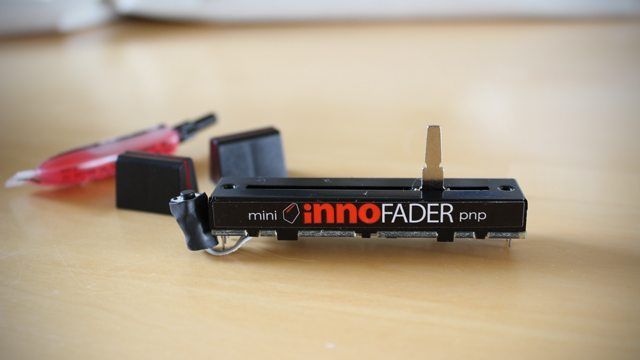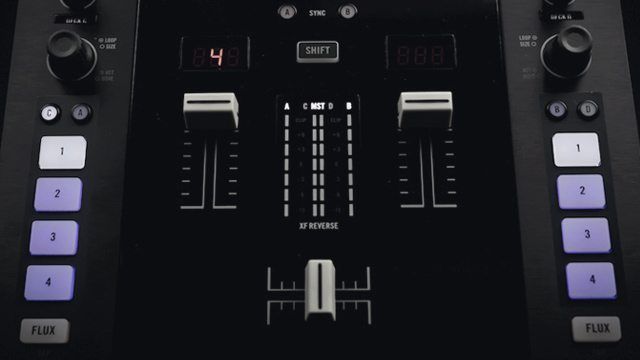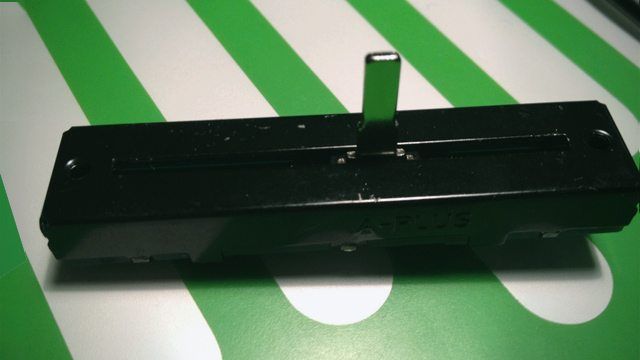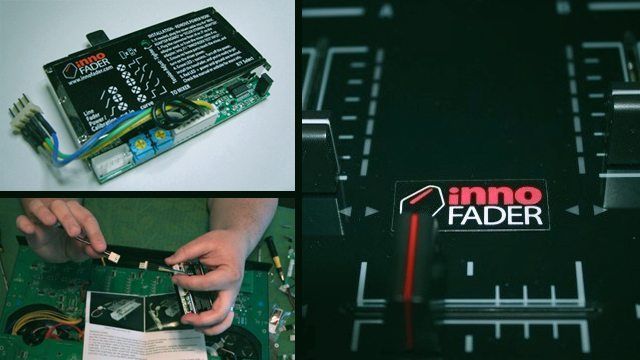Audio Innovate has been at the top of the aftermarket fader game for some time. Now they’ve brought out a plug-and-play version of their Mini Innofader, to fit into a huge variety of devices. Can it cut the (DJ) Mustard?
Reviewed: Mini Innofader PNP
Price: $100
Available: Now
The Good: A high-quality, long-lasting replacement fader that’s compatible with loads of popular DJ gear and comes with excellent customer support.
The Bad: It’s a bit expensive compared to most stock faders, and the installation can be a complex process depending on your hardware. Fitting instructions for beginners could be more detailed.
A RETURN TO CONSUMABLES?
In a time when some DJ technology seems ever more disposable, for many, the concept of consumables (ie. user replaceable parts) might seem almost anachronistic. Not so, back in the day: Every few months, new styli. Once a year (if you were lucky), a new crossfader.
Of course, that’s going back a while, when stock faders were generally pretty awful. I remember my Gemini PS-525, on which the crossfader started bleeding after about two days of use. Since then, we’ve seen huge advancements in the field of fader technology, with conductive plastic, optical, magnetic, and capacitance-based options all pushing beyond the limitations of traditional carbon-rail faders. If those terms mean nothing to you, this feature will get you up to speed.
Audio Innovate first brought their take on DJ faders to the market in 2008, with their capacitance-based Innofader, the original version of which has now been replaced by the Pro and PNP (plug-and-play) models. Thanks to being hugely adjustable, long-lasting, and shoehorn-able for nearly every device possible, the Innofader has proved to be a very highly regarded product.
One problem: Compared to the faders that come factory-installed in many mixers and the vast majority of controllers, the original Innofader is physically huge—and a lot of those devices are very economical when it comes to the space available inside them. Having a thousand different connection options is all well and good, but the only way the original Innofader is going to work with something like a DDJ-SX, is if you were to gaffer tape it to the outside. Audio Innovate did come out with some pretty ingenious solutions to fitting the unit into different spaces, like the Innobender, but ultimately, you can’t fight the laws of physics.
So a smaller version of the Innofader was the natural next step. The Mini first appeared in the Native Instruments Kontrol Z2 mixer back in 2012, and subsequently in the DJ Tech DIF-1S last year. That Mini model was first only available to manufacturers, to install as original equipment, but, as of this month, Audio Innovate has finally launched an aftermarket version for end users to fit in their existing gear.
CUSTOMER SERVICE
The OEM version of the Mini was not entirely free of issues—the original design, since modified, had some production problems. However, as you can see here, Audio Innovate was quick to respond to the matter, and was willing to replace the affected units. I also personally had a problem of uneven cut-in on the crossfader in my new Z2 earlier this year. I probably could have fiddled around with the calibration, but NI immediately sent me a replacement, and that one has been working perfectly for a few months now.
I highlight those problems not to say that the Mini is a bad product (it isn’t), but to make it clear that the level of customer service from Audio Innovate is superb. You’ll often hear the name Elliot Marx associated with the Innofader, and that’s not because the company is a one-man band, but because Elliot is the engineer behind their products, and he appears to be totally committed to ensuring buyers get the products and support they need. That’s something I always find very reassuring in any company.
FITTING THE P VERSION
Once you’ve visited the site to ensure your hardware is compatible with the Mini, and you’ve got one in your sweaty paws, the next step is to check which type of connector cable you need, and what kind of washers or plates you’ll need to mount the fader at the correct height. There is a whole bunch of mounting hardware included with the Mini, most of which you won’t need, but it’s good to have the whole lot around if you change your gear in the future and want to take the fader with you.
Be under no illusions—transplanting this fader into a lot of equipment is not incredibly difficult, but it is also no trivial matter. I go through the installation steps for my DDJ-SX in my video above, and I’m pretty sure that’s one of the simpler installs, but it still took 25 minutes and was pretty fiddly; and even after that, I needed to pull it out again to mount extra washers as the fader sat too high.
Audio Innovate provide good, detailed instructions for fitting the Mini (if perhaps a touch ‘engineer speak’ style), so as long as you have patience, then you will get it done right.
CALIBRATION
Due to the diminutive size of the Mini, there are no adjustment screws on the body, as with the full-size Innofader. All adjustment and calibration is done via a combination of holding the small button on the base of the fader and swiping the fader through different positions before releasing it. That means you’ll have to remove the fader to do it, although thankfully, unless you change your mind about things, you should only have to muck around with that at the time of install. It’s a pretty elegant solution considering the physical restrictions involved.
The fader stem is grounded on the Mini, unlike the original Innofader, which means you don’t have to have the fader cap fitted to do the calibration. That sounds like a small thing, but it can be quite a time-saver when doing your first setup.
FEEL AND PERFORMANCE
The PNP version of the Mini feels identical to the OEM version installed in my Kontrol Z2—slick, but still controllable, and with silicone stops at each end to provide a nice dull thud, rather than the nasty metallic click found in some faders (anyone remember the Numark SM1? You could wake the dead if you were cutting with that thing).
Handily, the Mini will still respect the curve control built into your mixer or controller, meaning you aren’t committed to a scratch-happy setting all the time. By calibrating to a sharper or smoother setting, you can tweak the curve a little, but not so much that you can turn a mixer with no curve control into a scratch beast.
It doesn’t have the massive 8 mm wide fader stem of the original Innofader, but I suspect if you are killing regular 4 mm stems on a regular basis, you ought to practice a lighter touch, or think more carefully about how you throw your gear into your bag. The standard stem size should also make finding replacement caps a lot easier in a pinch (although two are included with the fader anyway).
Overall, I’m very happy with the performance side of the Mini. Whether you’re a full-on hardcore turntablist, or a rudimentary scratcher like myself, the fader works well enough for you to pull off whatever techniques your ability will allow. A touch of lubricant (some is included in the box) every now and again should have you cutting happily for a long time to come.
MINI INNOFADER PNP — S VERSION
The version of the Mini that I tested is the P version, and comes with all the mounting hardware bits. The box of the S version is far less populated, containing the fader, lube, fader caps, and that’s it. The reason being is that the S version is designed to be soldered directly onto the board inside your hardware, meaning controllers like the Native Instruments Kontrol S2 and the Numark Mixtrack Pro can benefit from some Innofader goodness. That also means you can’t access the base of the fader for calibration, so the button is on a small little breakout lead instead. Smart thinking.
Compared to fitting the P version, fitting the S is like doing a degree in astrophysics. Aside from the soldering part, you need to adjust jumper switches to ensure the fader is set to receive the right voltage that the controller is providing. That’s not to mention the fact that, chances are, any hardware without a user-replaceable fader is simply not designed to be cracked open in the first place.
The P version still makes a lot of sense, though; even if you aren’t into scratching, going through all the case opening and soldering to replace your crossfader will be required a lot less regularly if you opt for an Innofader Mini, instead of a straight replacement fader which will likely die pretty quickly again next time.
WRAP-UP
As a Z2 owner, I was already well familiar with the Innofader Mini before it even hit the stores as an aftermarket accessory. There were only two questions I had about the PNP version:
1. Would it feel and perform as well as the OEM version?
It certainly does. Identical really, but with the added benefit of extra onboard configuration.
2. How easy is the process of fitting it into hardware which was not designed for it?
Depending on the precise configuration, it’s either fiddly, or all-out difficult. But, it’s certainly achievable for the average DJ. The S version is only for the brave and experienced solderer, of course, but it’s definitely a valuable option in the lineup.
Priced at around the $90 for the S version and $100 for the P model, the Innofader Mini isn’t perhaps the super-budget solution some (me) had hoped it might be. But it is likely to outlast at least a couple of standard carbon-rail faders, if not many more, so the value proposition starts to look better when taking that into account.
And if you absolutely must have wiki-wiki scratchiness in a compact little controller like the Kontrol S2, well, there’s simply no other option out there. Good stuff.









